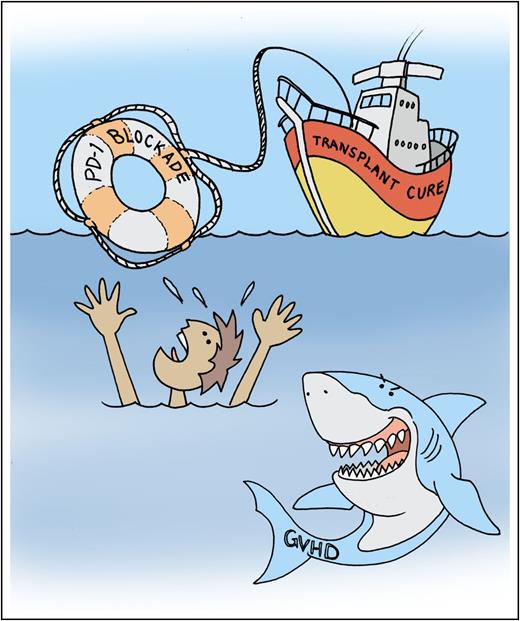In this issue of Blood, Haverkos et al present timely and compelling data revealing both the opportunity and serious hazards incurred with the use of programmed death 1 (PD-1) pathway blockade after allogeneic hematopoietic cell transplant (allo-HCT) in relapsed lymphoma patients.1
PD-1 blockade for progressive cHL after allo-HCT may rescue patients. The high risk of severe untreatable GVHD must be tamed before curative prospects can be realized in most patients. Professional illustration by Patrick Lane, ScEYEnce Studios.
PD-1 blockade for progressive cHL after allo-HCT may rescue patients. The high risk of severe untreatable GVHD must be tamed before curative prospects can be realized in most patients. Professional illustration by Patrick Lane, ScEYEnce Studios.
The enthusiasm for cancer immunotherapy is fueled by studies showing meaningful responses in several refractory solid tumors and lymphomas. In rapid succession over the last 4 years, objective responses and survival benefit have been demonstrated in many settings, including melanoma, lung, renal, and bladder cancers. Among lymphoid tumors, classical Hodgkin lymphoma (cHL) has stood out as remarkably responsive to PD-1 blockade. Initial studies show activity with 85% response rates and 86% 2-year progression-free survival in relapsed and refractory disease.2
The authors, assisted by the Center for International Blood and Marrow Transplant Research, which records basic data for every patient undergoing HCT, identified 15 high-volume centers that had used PD-1 monoclonal antibodies (mAbs) after allo-HCT. Although not eliminating selection bias, this approach provided a reasonably representative sample for estimating the response rates and incidence of adverse events in the absence of a prospective study. Chart reviews provided data on response and on acute or chronic graft-versus-host disease (GVHD) that emerged after initiation of anti–PD-1 therapy. Twenty-nine cHL patients, 1 with follicular lymphoma (FL) and 1 with composite FL and cHL, were included in the analysis. Consistent with the anti–PD-1 cHL literature, they found a high response rate of 77%. The median follow-up of only 428 days is too short to allow firm conclusions on clinical benefit, but median overall survival was not yet reached. However, the rapid onset (after 1 or 2 doses of PD-1 mAb) of severe GVHD in 55% of patients, with only 2 of these 17 patients having a complete response to GVHD therapy, is troubling.
The relatively benign toxicity signal seen in most settings, including cHL, has fostered the perception that the risk/benefit of single-agent anti–PD-1 mAb therapy favors increased off-label use of these agents in settings where good standard options are limited. However, the widespread acceptance of immune-based therapy continues to require critical evaluation. Case reports and an earlier smaller retrospective report by Hebaux et al3 suggested that the use of nivolumab after allo-HCT for cHL had an extraordinary response rate with a low rate of GVHD, providing cautious optimism for PD-1 in this setting. So why not combine PD-1 checkpoint inhibition with allo-HCT? The current report in Blood by Haverkos et al heralds a portentous check on that point of view.1
Improved survival with allo-HCT in diseases, such as AML, depend on reduced GVHD- and treatment-related mortality. The evaluation of survival benefit in cHL is more complex and less certain.4 Any effect that creates additional treatment-related risk is likely to adversely affect overall survival in cHL patients undergoing allo-HCT with PD-1 blockade. However, the efficacy signal, reported in terms of response, is intriguing and suggests that giving the donor T cells a second chance with immunotherapy could outweigh the associated risk (see figure). Thus, puzzling out those who will or will not benefit from integrating allo-HCT and PD-1 checkpoint blockade is a critical need.
It will be essential to gain a practical understanding of the complex interactions between PD-1 (as well as other checkpoint molecules) and immunostimulatory molecules, such as CD80, that stimulate the antitumor response and provoke autoimmunity and exacerbate GVHD. In a study of ipilimumab,5 which provided initial data for efficacy in AML, dose-limiting GVHD occurred in 14% of subjects with no deaths compared with the 55% GVHD occurrence rate and the 26% GVHD-related deaths seen in the current report by Haverkos et al. Although the patient populations are different, the possibility that anti–PD-1 treatment is associated with a higher incidence of new onset acute and chronic GVHD should be evaluated.
Well designed correlative studies are needed to reexamine various allo-HCT strategies aimed at understanding immunologic mechanisms to tilt the balance toward the antitumor effects. For example, the role of T-cell depletion may be approached in a novel way when immune checkpoint inhibitors are incorporated in allografting.6 The package insert “black box warning” for nivolumab highlights severe hyperacute GVHD when allo-HCT is performed after nivolumab therapy for cHL.
This is both an opportunity and a challenge for clinicians to prioritize this strategy in the setting of clinical trials. Basic questions of patient selection, prior use of checkpoint inhibitors, treatment of ongoing GVHD, optimal doses, and schedules need to be answered. The early emergence of severe GVHD after 1 or 2 doses of PD-1 must be addressed. Once the therapeutic opportunity has been identified, well designed clinical trials based on preclinical and clinical data will best protect patients and foster advances in this emerging field. Given the compelling efficacy suggested in the clinical data, refining this approach may well lead to curative therapy for these patients for whom cure has been an elusive goal.
Determining the proper place for immunotherapy in allo-HCT for cHL should have high priority to provide insights into how to proceed further. For the present, incorporation of allo-HCT and PD-1 blockade should not be performed outside of clinical trials.
Conflict-of-interest disclosure: The authors declare no competing financial interests.


This feature is available to Subscribers Only
Sign In or Create an Account Close Modal